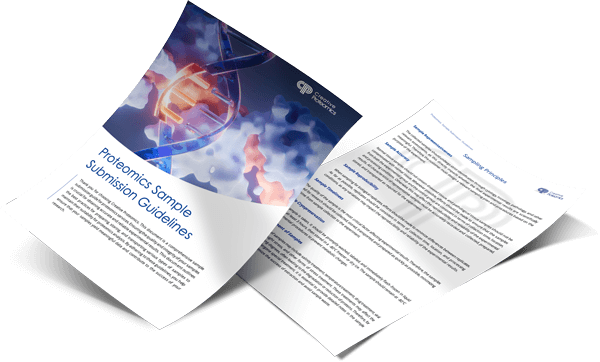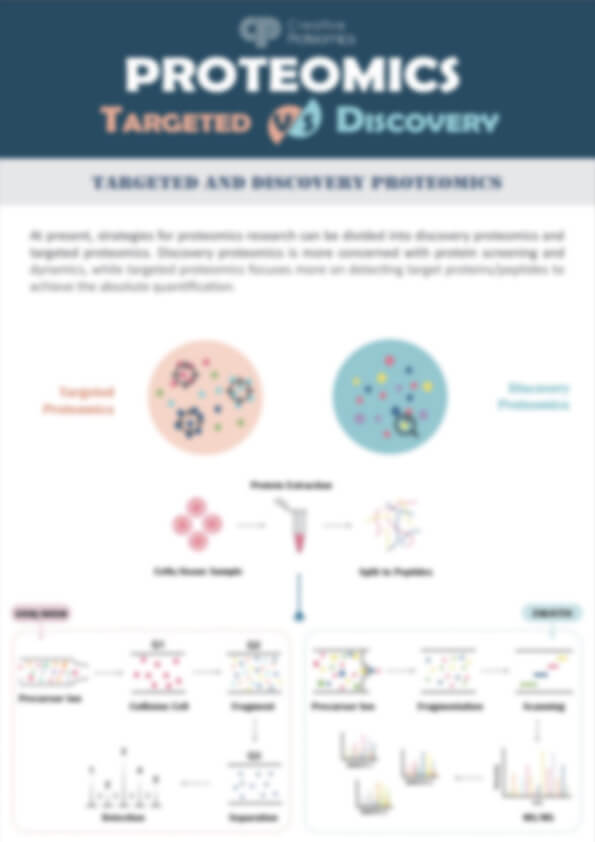Ubiquitinated Proteomics Analysis Service
Creative Proteomics offers advanced ubiquitinated proteomics services, including protein extraction, enrichment, LC-MS/MS analysis, and data interpretation. Our solutions enable precise identification of ubiquitination sites, quantification of modified proteins, and in-depth bioinformatics analysis, helping you uncover critical insights into protein regulation and disease mechanisms.
Submit Your Request Now
×- What We Provide
- Technology Platform
- Advantages
- Sample Requirements
- FAQs
- Case
- Publications
What Is Protein Ubiquitination
Protein ubiquitination is a prevalent and essential post-translational modification (PTM) in eukaryotes. It is the process that ubiquitin (Ub) links to lysine (K) residues and N-terminal methionine (M) sites on proteins through a cascade mechanism catalyzed by enzymes (E1, E2, E3). Ultimately, the 26S proteasome specifically targets and degrades the ubiquitinated proteins. Reversibly, under the catalysis of deubiquitinases (DUB), Ub can be dissociated from substrate. Additionally, Ub containing seven K and one M at N-terminal, Ub covalently attached to proteins can still be further modified by other Ubs to form poly-Ubs (figure 1). According to the number of Ub on protein, it can be divided into mono-ubiquitination and poly-ubiquitination, and poly-ubiquitination can be divided into linear poly-ubiquitination chain and non-linear poly-ubiquitination chain. In a word, a protein may have multiple ubiquitination sites, and each site may be linked to more than one ubiquitination molecule and contains unique functions.
The location and amount of protein ubiquitination play a crucial role in determining its functions. It plays a pivotal regulatory role in all biological processes, especially in regulating protein quality control, encompassing the degradation of misfolded, dysfunctional, or otherwise aberrant and unnecessary proteins. When there is aberrant expression of Ub or functional mutations in E1, E2, or E3 enzymes, it can lead to abnormal protein degradation and accumulation, potentially contributing to the development of various diseases. Therefore, a systematic study on ubiquitination helps us gain a profound understanding of the pathogenicity molecular mechanism and develop novel strategies to combat diseases.
 Figure 1. The cycle of Ub signaling and Ub proteoforms[1].
Figure 1. The cycle of Ub signaling and Ub proteoforms[1].
(A) The UPS. (B) The various forms of polyUb-chain.
Table 1. Individual ubiquitin linkage types and their associated biological roles [2].
| Types of ubiquitin chains | Functions |
|---|---|
| K6 | 1) Mitophagy; 2) DNA damage response |
| K11 | 1) Cell cycle and mitosis regulation; 2) Membrane trafficking; 3) Mitophagy |
| K27 | 1) DNA damage response; 2) Host response to microbial DNA; 3) T-cell development; 4) Proteasomal signaling |
| K29 | 1) Proteasomal signaling |
| K33 | 1) Regulation of TCR response |
| K48 | 1) Proteasomal Degradation |
| K63 | 1) Regulation of NF-κB signaling; 2) Transcriptional activation; 3) DNA damage response; 4) Lysosomal targeting a. Autophagy b. Receptor internalization; 5) Protein-protein interactions |
| M1 | 1) Regulation of NF-κB signaling; 2) Protein kinase activation; 3) Protein-protein interactions |
What We Can Offer?
Ubiquitinated Protein Extraction & Enrichment
- Highly Specific Antibodies: We use advanced antibody-based methods to efficiently enrich ubiquitinated peptides from complex samples.
- Fractionation Methods: For large-scale, high-throughput projects, we employ protein or peptide fractionation to enhance the coverage of ubiquitination sites.
LC-MS/MS Analysis for Ubiquitination Site Identification
Our experts utilize LC-MS/MS to detect and identify ubiquitination sites with high sensitivity and specificity.
Quantitative Proteomics
By employing advanced techniques like TMT (Tandem Mass Tag) and iTRAQ (Isobaric Tags for Relative and Absolute Quantitation), we offer accurate quantification of ubiquitinated proteins across different samples.
Data Analysis and Bioinformatics
We offer comprehensive bioinformatics services to analyze the ubiquitinated proteome data, including functional annotation, pathway enrichment, and protein interaction mapping.
Customized Reports
Our final reports offer detailed insights, including experiment procedures, data analysis results, and potential applications of your findings.
 Figure 2. MS-based approaches for identifying ubiquitination sites[3].
Figure 2. MS-based approaches for identifying ubiquitination sites[3].
Methods for Ubiquitinated Proteomics Detection
- Q-Exactive: This high-performance mass spectrometer enables ultra-high resolution and accurate mass measurements of ubiquitinated peptides.
- Q-Exactive HF: Known for its superior resolution and sensitivity, the Q-Exactive HF is essential for identifying low-abundance ubiquitinated proteins with high confidence.
- Orbitrap Fusion™ Tribrid™: This advanced mass spectrometer combines the best features of quadrupole, Orbitrap, and ion trap technologies for maximum sensitivity, specificity, and coverage in ubiquitination analysis.
Our use of these powerful tools ensures precise detection, accurate identification of ubiquitination sites, and high-throughput analysis of thousands of proteins in a single run.

Q Exactive™ Plus Hybrid Quadrupole-Orbitrap™ Mass Spectrometer (From Thermo Scientific)

Orbitrap Fusion™ Lumos™ Tribrid™ Mass Spectrometer (From Thermo Scientific)
Advantages of Our Ubiquitinated Proteomics Assay
- Exceptional Sensitivity Detection Limit: With instruments like the Q-Exactive HF and Orbitrap Fusion™ Tribrid™, we detect ubiquitinated proteins at sub-femtomolar levels and 10–100 pg per sample, uncovering even the lowest-abundance proteins.
- Deep Coverage of Ubiquitination Sites: Our analysis identifies hundreds of ubiquitination sites per sample, with recent studies revealing over 300 unique sites in a single run, enabling comprehensive profiling of the ubiquitome.
- Unmatched Resolution and Accuracy: Achieving 140,000 resolution at m/z 200, our mass spectrometers provide precise identification of modified peptides, reducing data ambiguity and enhancing the confidence of ubiquitination site detection.
- Scalable High-Throughput Analysis: We process up to 1000 samples simultaneously, making our service ideal for large-scale biomarker discovery and drug screening.
- Advanced Bioinformatics and Data Analysis: Our custom bioinformatics tools ensure robust data interpretation, identifying K63-linked chains in inflammation studies with >95% reproducibility in replicate samples.
- Rapid Turnaround Time: We deliver high-quality results in 2–4 weeks, ensuring quick progress for your research.
- Tailored to Your Needs: We offer customized solutions for specific ubiquitin chains or protein targets, providing the most relevant data for your project.
Sample Requirements for Ubiquitinated Proteomics Analysis
| Sample Type | Minimum Amount | Concentration Requirement | Additional Notes |
|---|---|---|---|
| Tissue | > 100 mg | - | Please provide fresh or frozen tissue samples. Avoid using samples with significant degradation. |
| Fresh Plant Material | > 500 mg | - | Fresh, non-degraded plant tissue works best for proteomic analysis. |
| Suspension Cells | > 5 x 10⁷ cells | - | Cells should be collected in a cell suspension buffer. Avoid contamination with serum or other factors. |
| Adherent Cells | > 5 x 10⁷ cells | - | Cells should be harvested using gentle methods (e.g., trypsinization or scraping). |
| Microorganisms | > 100 mg or 5 x 10⁷ cells | - | Use fresh cultures and avoid sample contamination. |
| Body Fluids | > 1 mL (serum/plasma) | - | Serum or plasma should be collected with appropriate anticoagulants and stored properly. |
| Total Protein | > 5 mg | > 1 μg/μL | Protein samples should be in a clean buffer free of contaminants like nucleic acids, lipids, and salts. |
Applications of Ubiquitinated Proteomics Assay
Protein Quality Control
Identifies and quantifies misfolded or damaged proteins targeted for degradation by the proteasome, essential for understanding cellular homeostasis and disease mechanisms.
Cancer Research
Uncovers ubiquitination patterns involved in cancer progression, offering potential biomarkers and therapeutic targets for personalized cancer treatments.
Neurodegenerative Diseases
Investigates the role of ubiquitin in protein aggregation and degradation in diseases such as Alzheimer's and Parkinson's, aiding in the development of therapeutic strategies.
Immune Response Regulation
Explores how ubiquitination regulates immune cell signaling, including T-cell activation and cytokine release, with implications for autoimmune diseases and immunotherapy.
Signal Transduction and Cellular Signaling
Analyzes the ubiquitination of signaling proteins, shedding light on critical pathways such as NF-κB, apoptosis, and stress response, contributing to drug discovery.
Drug Development
Assists in identifying new drug targets by mapping the ubiquitin-modified proteins involved in disease pathways, helping in the development of ubiquitin-related therapies.
Infectious Disease Research
Investigates how pathogens manipulate host ubiquitin pathways to promote infection, aiding in the design of antiviral and antibacterial treatments.
FAQ of Ubiquitinated Proteomics Analysis
Do I need to separate ubiquitinated proteins from other proteins in my sample?
While it's not mandatory to separate ubiquitinated proteins, we recommend an enrichment step for better sensitivity and detection. Techniques like immunoprecipitation or ubiquitin-affinity purification help isolate ubiquitinated peptides from the total proteome. This reduces the complexity of your sample, making the analysis more focused and efficient, especially for challenging samples with low ubiquitin modification.
Can I use formalin-fixed paraffin-embedded (FFPE) tissue for ubiquitination analysis?
FFPE tissues are more challenging for proteomics analysis due to cross-linking and protein degradation. While ubiquitinated proteomics from FFPE samples is possible, the tissue preparation process must be optimized to reverse cross-links and recover proteins in a usable state. We recommend using fresh or flash-frozen tissues for optimal results. If FFPE samples are the only option, please contact us to discuss preparation protocols.
What is the role of deubiquitinases (DUBs) in your ubiquitination analysis?
Deubiquitinases (DUBs) are enzymes that remove ubiquitin from substrates. While they are important in regulating ubiquitination dynamics, they can also interfere with the detection of ubiquitinated proteins. During analysis, we make sure to control for any DUB activity that could affect our results. If studying DUB activity is part of your research, we can tailor the experiment to focus on specific DUB inhibitors to better understand their impact on ubiquitin signaling.
What if my sample contains multiple ubiquitin modifications on the same protein?
When a protein undergoes multiple ubiquitination events, such as multiple ubiquitin chains or a combination of mono- and poly-ubiquitination, our analysis can still effectively map all modifications. We use high-resolution MS methods that can differentiate between various ubiquitin modifications and their precise sites. This allows for a comprehensive view of how different types of ubiquitination influence the protein's function, stability, and interactions.
Learn about other Q&A.
Ubiquitinated Proteomics Analysis Case Study

Rewiring of the ubiquitinated proteome determines ageing in C. elegans
Journal: Nature
Published: 2021
Main Technology: Label-free quantitative ubiquitinated proteomics
- Background
- Methods
- Research results
- Reference
Ubiquitination is one of the most common protein degradation pathways in eukaryotes. By labeling proteins with ubiquitination, they are recognized and degraded by the 26S proteasome in cell (this process can be reversed by the deubiquitinating enzymes). The attachment of the small protein ubiquitin to lysine residues of specific targets is a central pathway by which cellular decisions are made, but the effect of ubiquitination in ageing remains unclear.
We compared the ubiquitin (Ub)-modified proteome of worms at the first day of adulthood with young (day 5), mid-age (day 10) and aged adults (day 15). With high reproducibility between biological replicates, our assay identified ubiquitination sites for 3,373 peptides that correspond to 1,485 distinct proteins. With more analysis, given that C. elegans undergoes a widespread proteome remodelling during ageing, differences in ubiquitination levels could not be simply ascribed to a similar change in the protein amounts.
1. Remodeling of ubiquitinated proteomes occurs during aging.
2. Deubiquitinating enzyme inhibited protein ubiquitination occurs with age.
3. Degradation of proteasome targets is hindered with age, Proteasome targets determine lifespan.
4. Illustrated two of proteasomal targets biological function, IFB-2 intermediate filament and the EPS-8 modulator of RAC signalling.
 Rewiring of the Ub-proteome with age.
Rewiring of the Ub-proteome with age.
Reference
- Koyuncu, Seda, et al. "Rewiring of the ubiquitinated proteome determines ageing in C. elegans." Nature 596.7871 (2021): 285-290. https://doi.org/10.1038/s41586-021-03781-z
Publications
Here are some publications in Proteomics research from our clients:

- Parkinson’s disease-associated LRRK2-G2019S mutant acts through regulation of SERCA activity to control ER stress in astrocytes. 2019. https://doi.org/10.1186/s40478-019-0716-4
- Trypanosoma cruzi DNA Polymerase β Is Phosphorylated In Vivo and In Vitro by Protein Kinase C (PKC) and Casein Kinase 2 (CK2). 2022. https://doi.org/10.3390/cells11223693
- The human CD47 checkpoint is targeted by an immunosuppressive Aedes aegypti salivary factor to enhance arboviral skin infectivity. 2024. https://doi.org/10.1126/sciimmunol.adk9872
- HDAC4 influences the DNA damage response and counteracts senescence by assembling with HDAC1/HDAC2 to control H2BK120 acetylation and homology-directed repair.. 2024. https://doi.org/10.1093/nar/gkae501
- Pair bonding and disruption impact lung transcriptome in monogamous Peromyscus californicus. 2023. https://doi.org/10.1186/s12864-023-09873-6
















